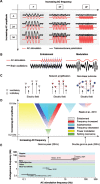Effects of weak transcranial alternating current stimulation on brain activity-a review of known mechanisms from animal studies
- PMID: 24167483
- PMCID: PMC3805939
- DOI: 10.3389/fnhum.2013.00687
Effects of weak transcranial alternating current stimulation on brain activity-a review of known mechanisms from animal studies
Abstract
Rhythmic neuronal activity is ubiquitous in the human brain. These rhythms originate from a variety of different network mechanisms, which give rise to a wide-ranging spectrum of oscillation frequencies. In the last few years an increasing number of clinical research studies have explored transcranial alternating current stimulation (tACS) with weak current as a tool for affecting brain function. The premise of these interventions is that tACS will interact with ongoing brain oscillations. However, the exact mechanisms by which weak currents could affect neuronal oscillations at different frequency bands are not well known and this, in turn, limits the rational optimization of human experiments. Here we review the available in vitro and in vivo animal studies that attempt to provide mechanistic explanations. The findings can be summarized into a few generic principles, such as periodic modulation of excitability, shifts in spike timing, modulation of firing rate, and shifts in the balance of excitation and inhibition. These effects result from weak but simultaneous polarization of a large number of neurons. Whether this can lead to an entrainment or a modulation of brain oscillations, or whether AC currents have no effect at all, depends entirely on the specific dynamic that gives rise to the different brain rhythms, as discussed here for slow wave oscillations (∼1 Hz) and gamma oscillations (∼30 Hz). We conclude with suggestions for further experiments to investigate the role of AC stimulation for other physiologically relevant brain rhythms.
Keywords: animal models; electroencephalogram (EEG); entrainment; gamma; oscillations; slow wave; transcranial alternating current stimulation (tACS); transcranial direct current stimulation (tDCS).
Figures

Similar articles
-
Frequency-Specific Modulation of Slow-Wave Neural Oscillations via Weak Exogeneous Extracellular Fields Reveals a Resonance Pattern.J Neurosci. 2022 Aug 10;42(32):6221-6231. doi: 10.1523/JNEUROSCI.0177-22.2022. Epub 2022 Jul 5. J Neurosci. 2022. PMID: 35790404 Free PMC article.
-
Alpha Power Increase After Transcranial Alternating Current Stimulation at Alpha Frequency (α-tACS) Reflects Plastic Changes Rather Than Entrainment.Brain Stimul. 2015 May-Jun;8(3):499-508. doi: 10.1016/j.brs.2014.12.004. Epub 2014 Dec 20. Brain Stimul. 2015. PMID: 25648377 Free PMC article.
-
Transcranial alternating current stimulation: a review of the underlying mechanisms and modulation of cognitive processes.Front Hum Neurosci. 2013 Jun 14;7:279. doi: 10.3389/fnhum.2013.00279. eCollection 2013. Front Hum Neurosci. 2013. PMID: 23785325 Free PMC article.
-
Entrainment and Spike-Timing Dependent Plasticity - A Review of Proposed Mechanisms of Transcranial Alternating Current Stimulation.Front Syst Neurosci. 2022 Feb 24;16:827353. doi: 10.3389/fnsys.2022.827353. eCollection 2022. Front Syst Neurosci. 2022. PMID: 35283735 Free PMC article. Review.
-
EEG oscillations: From correlation to causality.Int J Psychophysiol. 2016 May;103:12-21. doi: 10.1016/j.ijpsycho.2015.02.003. Epub 2015 Feb 4. Int J Psychophysiol. 2016. PMID: 25659527 Review.
Cited by
-
Transient Amplitude Modulation of Alpha-Band Oscillations by Short-Time Intermittent Closed-Loop tACS.Front Hum Neurosci. 2020 Sep 4;14:366. doi: 10.3389/fnhum.2020.00366. eCollection 2020. Front Hum Neurosci. 2020. PMID: 33100993 Free PMC article.
-
A Real-Time Phase-Locking System for Non-invasive Brain Stimulation.Front Neurosci. 2018 Dec 3;12:877. doi: 10.3389/fnins.2018.00877. eCollection 2018. Front Neurosci. 2018. PMID: 30559641 Free PMC article.
-
Responses of model cortical neurons to temporal interference stimulation and related transcranial alternating current stimulation modalities.J Neural Eng. 2023 Jan 3;19(6):10.1088/1741-2552/acab30. doi: 10.1088/1741-2552/acab30. J Neural Eng. 2023. PMID: 36594634 Free PMC article.
-
Analyzing the advantages of subcutaneous over transcutaneous electrical stimulation for activating brainwaves.Sci Rep. 2020 Apr 30;10(1):7360. doi: 10.1038/s41598-020-64378-6. Sci Rep. 2020. PMID: 32355172 Free PMC article.
-
Frequency Band-Specific Electrical Brain Stimulation Modulates Cognitive Control Processes.PLoS One. 2015 Sep 25;10(9):e0138984. doi: 10.1371/journal.pone.0138984. eCollection 2015. PLoS One. 2015. PMID: 26405801 Free PMC article.
References
Publication types
Grants and funding
LinkOut - more resources
Full Text Sources
Other Literature Sources

